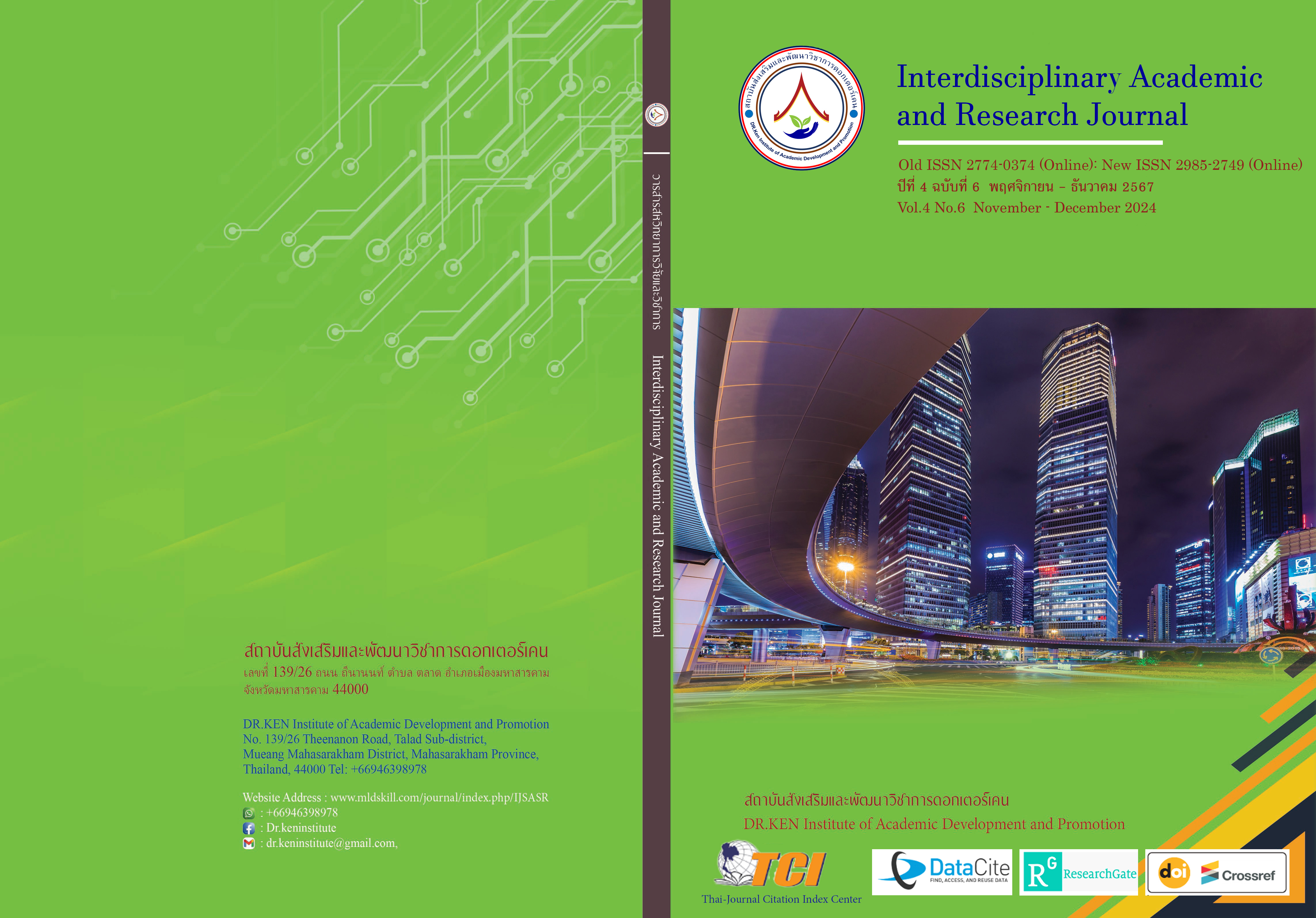Development of Puffed Rice from Pathum Thani 1 Rice as the Soft Power of Pathum Thani
DOI:
https://doi.org/10.60027/iarj.2024.279074Keywords:
Puffed Rice, Pathum Thani 1 Rice, Soft PowerAbstract
Background and Significance: Pathum Thani Province has natural resources such as fertile soil, water sources, and rice breed, as well as economic capitals such as agricultural produce distribution centers and large fisheries, Talat Thai, and Si Mum Mueang markets, along with industrial estates that draw laborers nationwide to the area, leading to cultural capital that is a unique cultural identity from all corners of the country. Therefore, the researcher aims to 1) examine the soft power in Pathum Thani Province that leads to product development and 2) develop puffed rice products based on the Pathum Thani 1 rice.
Research Method: This study uses a qualitative approach, with key informants being three entrepreneurs in three districts of Pathum Thani Province: Thanyaburi, Mueang Pathum Thani, and Lam Luk Ka Districts. The method was group discussion. The quantitative part was done using a relative moisture test using the AND ModMX50 Moisture, refractometer for sweetness and texture, or the TA XTplus texture analyzer.
Result: The result of the development of puffed rice from Pathum Thani 1 Rice in Pathum Thani Province was that 1) the study on the soft power of Pathum Thani Province which led to the development of puffed rice product showed that the product could be a soft power based on a cultural and wisdom trace of the Thai and Mon peoples; 2) result of puffed rice product development based on Pathum Thani 1 Rice showed that each district had its formula and trait, for example in Thanyaburi District, the Khao Dawk Mali 105 was used without a new formula being developed, in Mueang Pathum Thani District, rice berry rice was used and the formula was being constantly improved upon, while in Lam Luk Ka District, the old jasmine rice was used with government support. The physical quality test showed that the glazing water affected the moisture and texture of the puffed rice, as increasing the glazing water would result in a harder texture and higher moisture. The comparative test showed that the formulas based on the Pathum Thani 1 rice and Khao Dawk Mali 105 had no statistically significant difference, and it was appropriate for producing puffed rice.
Conclusion: the study revealed that the Pathum Thani 1 rice could improve the puffed rice quality into a soft power of Pathum Thani Province, by encouraging the use of the local ingredient in connection with the soft power concept which consisted of cultural, natural, and economic aspects, to develop one of the four requisites (food, shelter, medicine, and clothing) and a sustainable soft power product later on.
References
คมกฤช ฤทธิ์ขจร. (2567). การใช้เครื่องมือวิเคราะห์ Soft Power กับการพัฒนาผลิตภัณฑ์ชุมชนท้องถิ่น. การอบรมเชิงปฏิบัติการพัฒนาทักษะ Re-skill / Up Skill. โครงการยกระดับมาตรฐานผลิตภัณฑ์ชุมชนยั่งยืนสู่แพลตฟอร์มออนไลน์. 22 เมษายน 2567 โรงแรม Lacol Khaoyai, ปากช่อง, จังหวัดนครราชสีมา, ประเทศไทย.
ชนิดา บุพตา ศิวลักษณ์ ปฐวีรัตน์ และภัทราพร สัญชาตเจตน์. (2563). การศึกษาการพองตัวของข้าวด้วยเครื่องผลิตข้าวพองแบบแผ่น. วารสารสมาคมวิศวกรรมเกษตรแห่งประเทศไทย. 26(2), 37-46.
ปรีชา ตั้งสุขขีย์ศิริ และคณะ. (2564). แนวทางส่งเสริมการท่องเที่ยวบนพื้นฐานของซอฟต์พาวเวอร์ด้านอาหารพื้นถิ่นจังหวัดสุโขทัย. วารสารวิทยาการจัดการมหาวิทยาลัยราชภัฏพิบูลสงคราม. 4(2), 77-82.
สำนักงานจังหวัดปทุมธานี. (2566). พื้นที่เกษตรกรปลูกข้าว. Retrieved on 20 April 2024 from: http://www2.pathumthani.go.th/index.php
สำนักงานมาตรฐานผลิตภัณฑ์อุตสาหกรรม (2562). มาตรฐานผลิตภัณฑ์ชุมชน ข้าวพอง มผช.743/2562. กรุงเทพฯ: กระทรวงรุตสาหกรรม
สำนักงานส่งเสริมการจัดประชุมและนิทรรศการ สสปน. (2567). Soft Power อำนาจแห่งความสร้างสรรค์ เพื่อสรรค์สร้างเศรษฐกิจไทย. Retrieved on 10 April 2024 from: https://www.businesseventsthailand.com/th/press-media/news-press-release/detail/1461-soft-power-the-power-of-creativity-to-build-the-thai-economy
สำนักนายกรัฐมนตรี. (2566). แต่งตั้งคณะกรรมการยุทธศาสตร์ซอฟต์พาวเวอร์แห่งชาติ Soft Power. Retrieved on 10 April 2024 from: https://www.opm.go.th/opmportal/index.asp?pageid=1532
สุกาญจน์ รัตนเลิศนุสรณ์, นิศารัตน์ ตามสมัคร และ อัชฌาณัท รัตนเลิศนุสรณ์. (2566). การปลูกข้าวปทุมธานี1อินทรีย์แบบใหม่ร่วมกับสารชีวภาพผสมหัวเชื้อจุลินทรีย์นาโนแปลงใหญ่ของเครือข่ายชุมชนกรณีศึกษาอาเภอหนองเสือ จังหวัดปทุมธานี. วารสารวิจัย มหาวิทยาลัยเทคโนโลยีราชมงคลศรีวิชัย. 15(3), 735-736.
สุภาษิต ชูกลิ่น. (2563). การพัฒนาขนมขบเคี้ยวจากข้าวไร่พื้นเมืองนครเสริมโปรตีนผงจิ้งหรีดด้วยเครื่องเอกซ์ทรูเดอร์สกรูคู่สู่ผลิตภัรฑ์ทางการค้า. รายงานผลการวิจัย, มหาวิทยาลัยเทคโนโลยีราชมงคลศรีวิชัย
หอสมุดพระราชวังสนามจันทร์, (2567). Soft Power. Retrieved on 20 April 2024 from: https://www.facebook.com/suslibrary/posts/soft-powersoft-power.
Triamvithaya, C. (2022). Soft Power for Tourism Promotion Management in Taladphlu Community. ASIA PARIDARSANA, 43(2), 70–98. Retrieved from https://so01.tci-thaijo.org/index.php/asianreview/article/view/257316
Waiyakrud, K. (2024). Strategies for Creative Tourism Development in Ban Ngio Subdistrict, Sam Khok District, Pathum Thani Province. Interdisciplinary Academic and Research Journal, 4(3), 419–434. https://doi.org/10.60027/iarj.2024.275815
Downloads
Published
How to Cite
Issue
Section
License
Copyright (c) 2024 Interdisciplinary Academic and Research Journal

This work is licensed under a Creative Commons Attribution-NonCommercial-NoDerivatives 4.0 International License.
Copyright on any article in the Interdisciplinary Academic and Research Journal is retained by the author(s) under the under the Creative Commons Attribution-NonCommercial-NoDerivatives 4.0 International License. Permission to use text, content, images, etc. of publication. Any user to read, download, copy, distribute, print, search, or link to the full texts of articles, crawl them for indexing, pass them as data to software, or use them for any other lawful purpose. But do not use it for commercial use or with the intent to benefit any business.
















.png)


